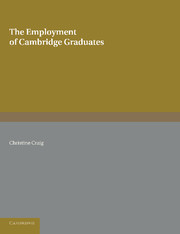Summary
Rate of response
(a) The men. 3748 men graduated in 1952 and 1953, of whom 594 could not be reached by post.
Of the remaining 3154, 2630 (83%) completed and returned the questionnaire. This represents a rate of response of 70% of the total number of graduates.
(b) The women. 613 women graduated in the years 1952, 1953, 1937 and 1938, of whom 59 could not be reached by post.
Of the remaining 554, 494 (90%) returned the questionnaire, representing a rate of response of 80% for the total number of graduates.
Background and qualifications (pages 6-15)
(a) The men. Their background was predominantly ‘bourgeois’, with parents belonging to the professional and managerial classes. Only 2% were the children of semi-skilled or unskilled workers.
Nearly two-thirds were educated at independent schools, just over a third at grammar schools (including direct grant schools).
Only 17% went straight to Cambridge from school. 66% were otherwise occupied for a period of one to three years. National Service was by far the commonest reason for the existence of this interval.
53% took degrees in arts subjects, 31% in science or mathematics, 11% in engineering. 9% achieved First Class Honours, 59% Second Class Honours, 26% Third Class Honours and 6% an Ordinary degree.
At the time of the survey the majority of the men were in the age group 29-33.
About a quarter were still bachelors, proportionally a little more than in the general population.
Two-thirds had acquired additional formal qualifications; certificates in education, medical or legal qualifications and Ph.D.s being the commonest.
Of the 2630 men who completed questionnaires all but 434 were working in the United Kingdom. 349 British nationals were working overseas. The remainder (53 Commonwealth and 32 foreign nationals) were working in their respective countries of origin.
(b) The women. Their home background was similar to the men, but relatively fewer were educated at independent schools. The majority went direct from school to Cambridge, where nearly two-thirds read for an arts degree, just over a third for a degree in science or mathematics.
The women gained relatively more Second Class Honours degrees and fewer Third Class Honours and Ordinary degrees than the men. The older group contained a significantly higher proportion of firsts than either the younger women or the men.
- Type
- Chapter
- Information
- The Employment of Cambridge Graduates , pp. 85 - 93Publisher: Cambridge University PressPrint publication year: 2013

